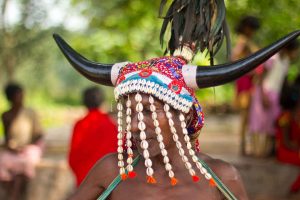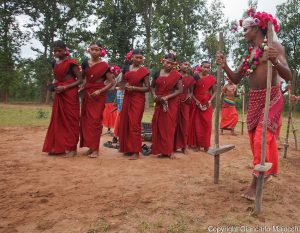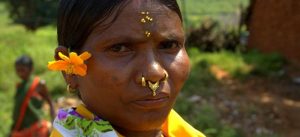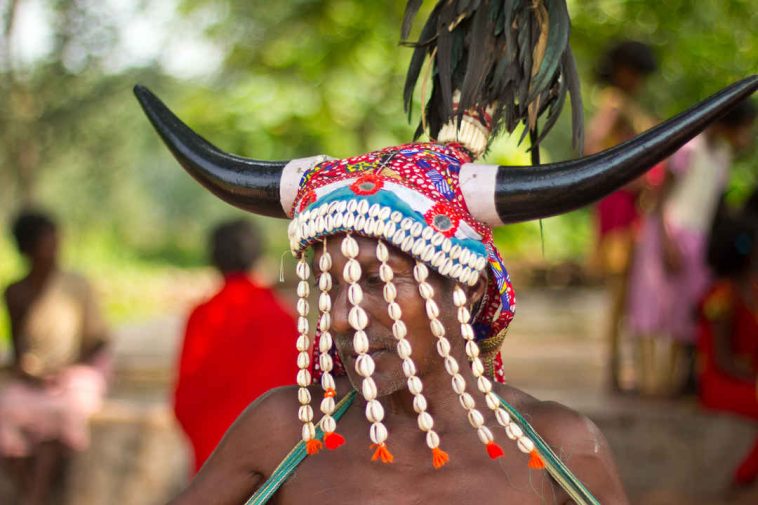Chhattisgarh is a land of diversity in itself. Situated in the middle of the country, it is famous for its unique culture and simplest lifestyle. Where there exist developed cities, such as Raipur and Bhilai, there also exist regions that are raw and untouched. Where still ancient old practices are followed, and traditions are preserved. There also exist rituals that are rarely known to the world. If dived deeply, they are far ahead, in terms of, their beliefs, and are relatable to modern-day yet away from superficial luxury.
Talking about the Tribes of Chhattisgarh, are unique in their lifestyles and have beautifully retained their own culture and traditions since overlapping centuries. They have a lot of unity within themselves and celebrate lives in their unique customary styles. In this article, we take you to the untold stories and traditions of tribes of Chhattisgarh; you will be amazed to read about!
HEADDRESS OF
BESOM HORN

⚫ NAAGMORI
Bison Horn Maria is one of the famous tribal groups of India. This tribal community of Chhattisgarh derived its name from their unique custom of wearing a distinctive headgear, which resembles the horns of a wild bison. They generally wear that headgear during marriage dances or other ceremonies.
The Bison Horn Maria men have got a distinct hairstyle of a long ponytail. The bison horn-shaped headgear worn by them is nowadays made of cattle horns because of the scarcity of bison horns. Those headgear are placed on a frame of bamboo and decorated with feathers of peacock or chicken and hanging cowry shell strings. Headgear is passed on from one generation to another.
GHOTUL
A MARRIAGE OF GOND
The three principal sub-castes of the aboriginal Gonds are the Dorla Maria and Muria races. The etymological significance of the term Gond is derived from the Telegu connotation “Kond” meaning hill The unique and one-of-a-kind Ghotul marriage tradition of the Gonds is renowned all across the world.
Under the Ghotul tradition, the tribal youths have complete freedom to choose their life partner. Ghotul is a type of bachelor’s dormitory, where all tribal boys and girls stay together to check their compatibility with each other before marriage.

AGRARIAN LIFE OF
HALBA
The quaint villages situated amidst the lap of nature are inhabited mainly by the tribals. The Halba tribe is a popular tribe who has happily settled in the rustic lands of Chhattisgarh, The Halba Tribals are widely dispersed all over Chhattisgarh,
The Halba tribe owes its nomenclature to the term ‘Hal’, which locally means plowing or farming. This implies the Halbas were primarily farmers, although nowadays, they are involved in a myriad of professions of their choice.

JEWELRY OBSESSION OF
ABHUJ MARIA
The Abhuj Maria race of tribal people is one of the principal subcastes of the Gond tribals. They have significantly preserved their archetypal tradition and customs. They are very fond of traditional ethnic jewelry and adorn themselves with several iron rings strung around their neck. The women love wearing earrings and sometimes pierce as many as 14 holes in their ears and hang two rings or studs from them. The Abhuj Maria tribals are more beneficial than humans in their characteristics.
FOLK MEDICINES OF
BAIGA
The Baiga are fierce protectors and worshippers of the forest and Mother Nature. Their sacred beliefs prohibit them from plowing the land as this is perceived as traumatizing Mother Earth. They, therefore, adopt the slash-and-burn form of shifting agriculture, constantly remaining on the move. Deaths in families lead to the abandonment of their dwelling and the building of a new one.
The tradition of folk medicine is still followed by the Baigas. The Baiga men are experts having in-depth knowledge of medicines. Various parts of plants are used as herbal medicines for any type of body ailments Le, body pain, headache, cough, stomach pain, cold, fever, a cut or small accident, etc. The Baigas treat them with their medicines.
In their social life, they are far further from the women of the rest of society, they enjoy the right participate in their decision-making system and are respected in their families and society
THE LAL BANGLA OF THE
BHUMJIYA TRIBE
The Bhujia tribes take special care of the cleanliness and hygiene of their habitat. Bhunjiya people build a separate house in their houses called Randha Ghar, whose roof is usually of grass and painted with the special kind of red soil found in the area. Among them, the Randha Ghar is called “Lal Bangla”. In connection with the “Lal Bangla”, it is believed that this place is of their deity. No one can touch this Randha Ghar other than the caste member.
In these, the rite of marriage is mandatory before the pre-menopause of the girl child in which the girl is married with an arrow. In these, the marriage proposal for marriage is from the groom’s side.
WEDDING CUSTOMS OF
KAMAR
The Kamar tribe traces its origins to Devdongar village of the Mainpur development block. Their biggest deity “Vaman Dev” is still enshrined in the “Vaman Dongri” of Devdongar.
With the help of a comb or “kakwa”, the hair forms a ponytail or bun. Kamar girls, at the age of 8-10 years, get tattoos made on their hands, feet, chin, etc. In jewelry, they wear Aethi on the wrist, Fulli on the nose, Khinwa in the ear, rupiamala around the neck, etc. Men wear Pancha
(small dhoti), bandi, and Saluki, and women wear lugda, and polka.
The marriage ceremony takes place under the supervision of elders in the Kamar tribe. In addition to normal marriages, gurvant and Ghar jarnai are also prevalent. Paithu (infiltration), and Udharia (Sahaplayan) get social acceptance after social punishment in the traditional social panchayat. The widow, remarriage is recognized. The widow’s sister-in-law can wear a bangle to her brother-in-law.
ARTIFICERS OF
DHURVAAS
The Dhurvaas is a proud, courageous, and highly caste-conscious race that only mixes with people of equal social standing. Their society is progressive and broadminded and polygamy is a common and accepted practice. The women, who are responsible for all domestic matters are held in high esteem and thus they are very haughty. The men are generally indolent and except for the routine cultivation and hunting, they don’t take much interest in domestic affairs. The tribal people are also talented craftsmen whose expertise is manifested by the exquisite handicrafts that they make out of cane and other forest products. Mirth and merrymaking are an eminent part of all celebrations.
NEOTERIC
MURIA TRIBE
The Murias are one of the innumerable tribes that inhabit Chhattisgarh. They are a prominent subcaste of the Gonds who dominate the populace of Chhattisgarh. Some Muria tribals also depend on collecting forest products The forest products are not only used to make useful products but the edible parts are also consumed by the tribals. In case of illness and maladies, they seek the remedial powers of the Mahua plant. Their society is quite progressive and Ghotul marriages are common practice.
VEILED TALES OF
PAHARI KORVA
Kalonil Dalton considered them to be a caste derived from the Kolarian group. Based on legends, they trace their origins to Ram-Sita. During exile, Ram-Sita and Lakshman were passing by a paddy field. To protect the crop from animals and birds, a mannequin effigy was caught with a bow and arrow and placed in the rams of the field. Sita Ji thought to curse in her mind. He asked Rama to give life to that effigy. Rama made the effigy a man. This effigy was the ancestor of the Korwa
tribe.
According to another belief, Lord Shankara created the universe. After that, with the idea of creating humans in the world, he made two humans from the Kala and Bala festivals of Ratanpur state. The name of a human made out of the soil of Kala Parvat is named Kila and the name of a human made out of the soil of Bala Mountain.
Subsequently, Shankar Ji constructed two female idols named Siddhi and Wisdom.
Kaila married Siddhi, who had three children, the first son was named Kol, the second son was named Korva and the third son was Kodaku. Korwa also had two sons, A son went into the mountain cut down the forests, and started cultivating dahiya, the hill was called Korwa. The second son cleared the forest and started permanent farming through the plow, called Dihari Korwa.




GIPHY App Key not set. Please check settings